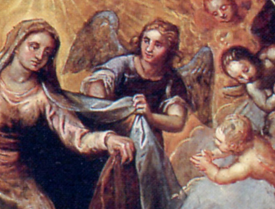
International conference call for papers
Ljubljana, France Stele Institute of Art History ZRC SAZU, May 11–13, 2017
Call for papers, deadline: March 10, 2017
Researching religious confraternities is a great challenge not only in the fields of general and church history but also in art history, as the activities of confraternities reflect strongly in fine arts. Confraternities connected European religious, cultural and artistic space in a way similar to monastic orders. Therefore, only a comprehensive understanding of their activities and role in fine arts can yield complex findings and new evaluation of these themes in a wider context.
With this conference, we wish to provide an opportunity to present new research findings and to discuss the significance of the artistic activities of confraternities in the Middle Ages and Early Modern Period, especially in the countries of Central Europe. Confraternities were one of the fundamental and the most dynamic expressions of piety in the Western world. As the indispensable part of the late medieval religious and social life, they left a significant mark in the fine arts. While in the time of Protestantism the confraternities were in decline, they reached a new heyday in the period of the Post-Tridentine recatholisation, especially in the 17th and the first half of the 18th century. Numerous early modern confraternities originated in the Middle Ages (the medieval confraternities were often related with guilds), and were, in accordance with the new religious tendencies, after the Council of Trent reformed as to emphasise their specific religious character. With the 1783 decree of Emperor Joseph II., the religious confraternities were abolished. This not only inflicted a loss in the pastoral activities of the Church, but also affected the artistic patrimonium. While the focus of the conference is the territory of the formal Habsburg hereditary lands, we also invite papers discussing the role of confraternities in the territories belonging to the Venetian Republic, where this form of religious life was supressed under the French occupation in 1806.
Our interest is the role of the confraternities in fine arts, as they were significant commissioners of artworks. They erected altars, chapels and churches, supervised their maintenance and decorating. They sponsored and participated in construction, renovation, furnishing and embellishing of churches, in which they worshipped their cults. They commissioned paintings, sculptures, prints, liturgical equipment and objects used in processions and celebrations. Some of confraternities had their own buildings or halls for meetings.
While we are open also for other themes that provide insight into artistic activities of confraternities, the main research questions we would like to discuss on the conference are:
- Confraternities as commissioners of artworks.
- The function of artworks: visualisation, religious cult and festive staging, manifestation of the social role of confraternities etc.
- The role of confraternities in introducing and dispersing new iconographic themes and types.
- Reception and modification of iconographic types or themes selected by archconfraternities.
- Material bases of confraternities and their influence on the artistic activities of confraternities.
- The main members and patrons or confraternities and their influence on art
- Artists commissioned by confraternities and artists as members of confraternities
- Confraternity patron saints and their role to the social needs in the specific historical, social and regional contexts.
- Art of confraternities who worked under auspices of monastic orders.
Since 2013, the project The Role and Significance of the Religious Confraternities in the Early Modern Art in Slovenian Lands has been conducted at the France Stele Institute of Art History ZRC SAZU with the financial support of the Slovenian Research Agency. The aim of the conference, which will take place in Ljubljana between 11 and 13 May 2017, is to discuss the complex and poorly researched theme of confraternities and fine art in the international context. With a wider insight into the phenomenon of the religious confraternities and their significance in the history of art, the conference will contribute to more comprehensive understanding of artworks and their religious and social role.
We invite art historians as well as historians, literary historians, church historians and researches in other similar disciplines to submit the proposals for 30-minute papers, consisting of the title and abstract (of maximum 1500 signs) together with a short CV, to our email address confraternitates.ars@zrc-sazu.si by March 10, 2017. The conference languages are English and German. The selection will be made by March 27th, 2017.
The organizing institute will subsidise travel expenses and accommodation costs of the speakers (maximum for 3 nights).
We plan to publish the proceedings in a peer-reviewed monograph, i.e. a regular thematic issue of the journal Acta historiae artis Slovenica (http://uifs1.zrc-sazu.si/?q=en/node/296). The journal is published by the France Stele Institute of Art History ZRC SAZU.
Organizers: Ana Lavrič, Barbara Murovec, Mija Oter Gorenčič
France Stele Institute of Art History ZRC SAZU